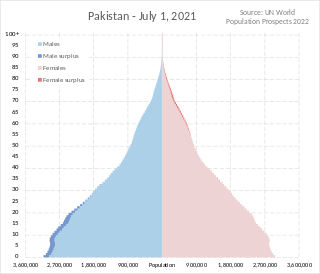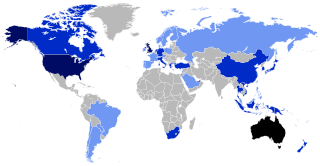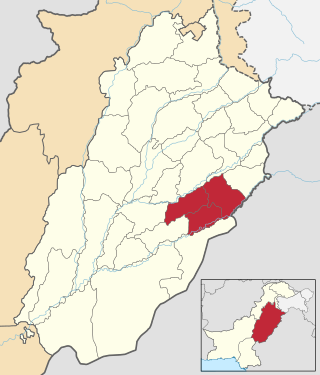
Pakistan, officially the Islamic Republic of Pakistan, is a country in South Asia. It is the fifth-most populous country, with a population of over 241.5 million, having the second largest Muslim population as of 2023. Islamabad is the nation's capital, while Karachi is its largest city and financial centre. Pakistan is the 33rd-largest country by area, being the second largest in South Asia. Bounded by the Arabian Sea on the south, the Gulf of Oman on the southwest, and the Sir Creek on the southeast, it shares land borders with India to the east; Afghanistan to the west; Iran to the southwest; and China to the northeast. It shares a maritime border with Oman in the Gulf of Oman, and is separated from Tajikistan in the northwest by Afghanistan's narrow Wakhan Corridor.

Pakistan had a population of 241,492,197 or 241.49 Million according to the final results of the 2023 Census. This figure includes Pakistan's four provinces e.g. Punjab, Sindh, KPK, Balochistan and Islamabad Capital Territory. AJK and Gilgit-Baltistan's census data is yet to be approved by CCI Council of Pakistan. Pakistan is the world's fifth most populous country.

Punjab is a province of Pakistan. Located in central-eastern region of the country, Punjab is the second-largest province of Pakistan by land area and the largest by population. Lahore is the capital and the largest city of the province. Other major cities include Faisalabad, Rawalpindi, Gujranwala and Multan.

Sindh is a province of Pakistan. Located in the southeastern region of the country, Sindh is the third-largest province of Pakistan by land area and the second-largest province by population after Punjab. It is bordered by the Pakistani provinces of Balochistan to the west and north-west and Punjab to the north. It shares an International border with the Indian states of Gujarat and Rajasthan to the east; it is also bounded by the Arabian Sea to the south. Sindh's landscape consists mostly of alluvial plains flanking the Indus River, the Thar Desert of Sindh in the eastern portion of the province along the international border with India, and the Kirthar Mountains in the western portion of the province.

Hyderabad is a city and the capital of Hyderabad Division in the Sindh province of Pakistan. It is the second-largest city in Sindh, and the fifth largest in Pakistan.

Sindhis are an Indo-Aryan ethnolinguistic group who speak the Sindhi language and are native to the Sindh province of Pakistan. The historical homeland of Sindhis is bordered by the southeastern part of Balochistan, the Bahawalpur region of Punjab and the Kutch region of Gujarat. Having been isolated throughout history, unlike its neighbours, Sindhi culture has preserved its own uniqueness.

Rawalpindi District is a district located in the northernmost part of the Punjab province of Pakistan. Parts of the district form part of the Islamabad Rawalpindi metropolitan area. Rawalpindi city is the district capital.
The demographics of Toronto, Ontario, Canada make Toronto one of the most multicultural and multiracial cities in the world. In 2021, 57.0 percent of the residents of the metropolitan area belonged to a visible minority group, compared with 51.4 percent in 2016, and 13.6 percent in 1981. Toronto also has established ethnic neighbourhoods such as the multiple Chinatowns, Corso Italia, Little Italy, Little India, Greektown, Koreatown, Little Tokyo, Little Jamaica, Little Portugal, Little Malta, Roncesvalles (Polish), and Bloor West Village (Ukrainian), all of which celebrate the city's multiculturalism. Data from the suburban municipalities are also included for some metrics as most of these municipalities are part of the Toronto CMA.

Asian Australians are Australians of Asian ancestry, including naturalised Australians who are immigrants from various regions in Asia and descendants of such immigrants. At the 2021 census, the proportion of the population identifying as Asian amounted to approximately 17.4 percent with breakdowns of 6.5 percent from Southern and Central Asia, 6.4 percent from North-East Asia, and 4.5 percent from South-East Asia.

Sahiwal District, formerly known as Montgomery district, is a district in the Punjab province of Pakistan.

Sukkur District is a district in Sindh Province in Pakistan. It is divided into 5 administrative townships, namely: Sukkur City, New Sukkur, Rohri, Saleh Pat and Pano Aqil. Among them Sukkur City and New Sukkur are urban centres, while Pano Aqil is famous for having one of the largest military cantonments of the country. Rohri is the smallest tehsil of Sukkur District, both in area and population, but it has an important railway junction.Two districts have been split off from the territory of Sukkur: Shikarpur in 1977 and Ghotki in 1993.

The official religion of Pakistan is Islam, as enshrined by Article 2 of the Constitution, and is practised by approximately 96.47% of the country's population. The remaining 3.53% practice Hinduism, Christianity, Ahmadiyya Islam, Sikhism and other religions.

Australians, colloquially known as Aussies, are the citizens, nationals and individuals associated with the country of Australia. This connection may be residential, legal, historical or ethno-cultural. For most Australians, several of these connections exist and are collectively the source of their being Australian. Australian law does not provide for a racial or ethnic component of nationality, instead relying on citizenship as a legal status.

Overseas Pakistanis, or the Pakistani diaspora, refers to Pakistanis who live outside of Pakistan. These include citizens that have migrated to another country as well as people born abroad of Pakistani descent. According to the Ministry of Overseas Pakistanis and Human Resource Development, approximately 8.8 million Pakistanis live abroad according to December 2017 estimates. According to the Ministry of Emigration and Overseas Employment, data released in 2023 states that more than 10.80 million people have moved abroad since 1990. beoe.gov.pk

Sahiwal Division is one of the nine Divisions of Punjab province, Pakistan.

Pakistanis are the citizens and nationals of the Islamic Republic of Pakistan. According to the 2017 Pakistani census, the population of Pakistan stood at over 213 million people, making it the world's fifth-most populous country. The majority of Pakistanis natively speak languages belonging to the Indo-Iranic family.
Pakistanis in Hong Kong are an ethnic minority in Hong Kong. According to Home Affairs Department, there are 24,385 Pakistani people live in Hong Kong constituting 4% of the population based on the 2021 census. According to the 2016 Official Census this population was then 18,094. In the 2011 census, 17,253 people were Pakistani nationals, and the number decreased to 15,234 in the 2016 census

Hinduism is a major religion and one of the most-followed religions in Asia. In 2020, the total number of Hindus in Asia is more than 1.2 billion, more than 26.2% of Asia's total population. About 99.2% of the world's Hindus live in Asia, with India having 94% of the global Hindu population. Other Asian nations with a notable Hindu population include Nepal, Bangladesh, Pakistan, Indonesia, Sri Lanka, Malaysia, and the United Arab Emirates.
Punjabi Australians are Australians who are of Punjabi descent. According to the 2016 census, Punjabi is one of the fastest-growing languages in Australia, with 132,499 individuals identifying as Punjabi-speakers. This is an increase from 71,230 individuals in 2011 and 26,000 individuals in 2006, representing a five-fold growth in 10 years.














